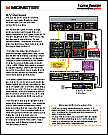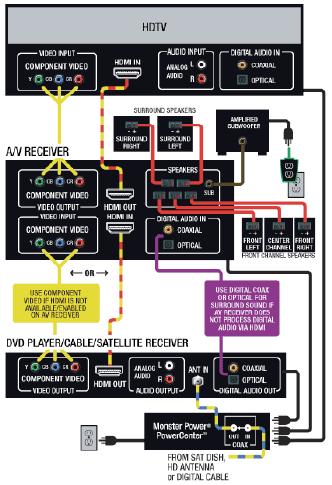AV Receiver Diagram
Resources Provided By MonsterCable.com
AV Receiver diagram pdf
The AV receiver diagram accepts audio and video input signals from your source components (DVD player, satellite TV receiver, digital cable box, HDTV tuner, etc), and then sends output to your TV and speaker system. That means you need to make the right connections both going in to the receiver and out from it.
• For video, the highest performance is achieved through digital HDMI (High Definition Multimedia Interface) or analog Component Video cable connections. HDMI and Component Video connections are capable of delivering high-definition video formats (720p, 1080i, 1080p) from capable sources to capable displays. Other lower-resolution (non-HD) connections can be made through either S-Video (better) or Composite Video connections (basic performance).
• For audio, digital connections are best and are required for surround sound formats like Dolby Digital® and DTS®. Use either a Fiber Optic or Digital Coax connection, depending on which ones your AV receiver and components feature. Your AV receiver may also be able to process surround sound, stereo and other audio formats via HDMI connections.
• A/V receivers also require Speaker Cable connections to each speaker. One exception may be your system's subwoofer - many powered subwoofers are connected to an AV receiver's "LFE" (Low Frequency Effects) or "Sub Out" port via a Subwoofer Interconnect Cable.




